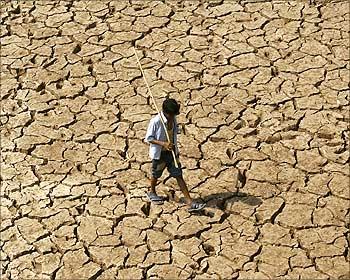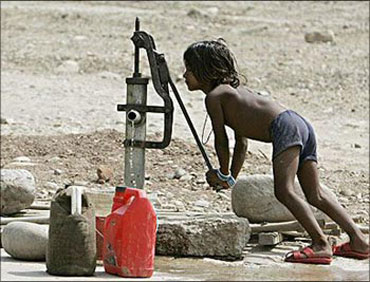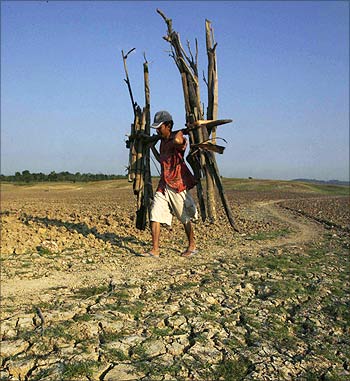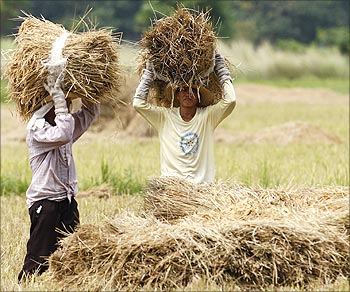Photographs: Ajay Verma/Reuters Sanjeeb Mukherjee in New Delhi
Though the India Meteorological Department forecast a normal southwest monsoon this year.
Commission for Agriculture Costs and Prices chairman Ashok Gulati tells Business Standard that IMD's prediction should be taken with a pinch of salt, as data shows there is usually a deviation of eight-10 per cent from the standard margin of error in many met predictions.
Edited excerpts:
IMD has predicted a normal monsoon this year, with only a 24 per cent chance of below-normal rains.
Do you think this should be viewed with a degree of suspicion?
Well, if you see the met office's forecast this year, it shows a 47 per cent chance of normal rains.
This, in other words, means the possibility of a normal monsoon this year is less than half.
Also, my experience in handling agriculture and related issues shows whenever we have had a longer-than-expected winter, like this year, the monsoon has been erratic.
. . .
'Possibility of a normal monsoon is less than half'
Photographs: Courtesy, Kerala Tourism
I feel south and central India would have normal rains, but in northwestern parts, there could be a break or a delay in monsoon rains.
However, it is my earnest wish that the predictions come true, as nobody benefits from uncertain rains.
But as of now, I'm neither gung-ho about the rains, nor excited.
Please elaborate on the reason for this suspicion.
IMD's first monsoon prediction deviated eight-10 per cent from the standard margin of error in many years, 2002 and 2009 being particularly bad.
But I wish I'm proved wrong and the forecast comes true.
. . .
'Possibility of a normal monsoon is less than half'
Image: A child collects water in Bihar.Photographs: Reuters
Let's assume the country gets uneven rains this year. Do you think we are better prepared than earlier years to handle this?
For wheat and rice, we don't have any problem.
On the contrary, a drop in production could indeed be beneficial from the point of view of managing stocks.
The real impact would be felt on coarse cereals, pulses, oilseeds and cotton.
For the first three, the irrigation rate is about 20 per cent, while for cotton, five per cent of the land is irrigated.
. . .
'Possibility of a normal monsoon is less than half'
Image: A man walks through a dried up dam after he collected firewood.Photographs: Sigit Pamungkas/Reuters
So, assuming rains are erratic this year, where do you think the price pressure would come?
Price pressures would develop in edible oils, imports would have to rise, and pulses could become costly if output drops.
In an abnormal monsoon scenario, controlling the prices of these commodities would be a big challenge.
Please throw some light on the correlation between rains and farm production.
In 2002, IMD forecast rains equivalent to 101 per cent of the long period average, while the actual rains were about 81 per cent.
. . .
'Possibility of a normal monsoon is less than half'
Image: Farmers harvest rice.Photographs: Darren Whiteside/Reuters
The foodgrain output dropped by 38 million tonnes to 174 million tonnes. (Rains between 96 and 104 per cent of LPA are considered a normal monsoon).
But in 2009, grain production dropped by just about 18 million tones, as rainfall distribution was not as bad.
That's why I'm just advising caution, as I think April is abnormally cool this time.
Do you think we can manage a drought?
Drought management broadly consists of enough foodgrain stocks, the capability to import and the ability to provide alternative employment to people who can't carry out farming.
We have ample foodgrain stocks, our forex reserves stand at about $300 billion, and we have programmes like the Mahatma Gandhi National Rural Employment Guarantee Scheme, which can provide sustainability.
Considering these , yes, we are better prepared to manage a drought.







article